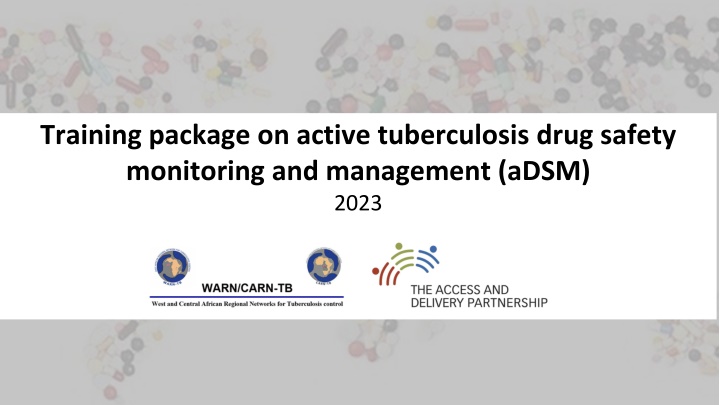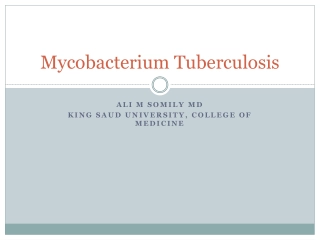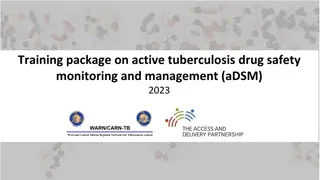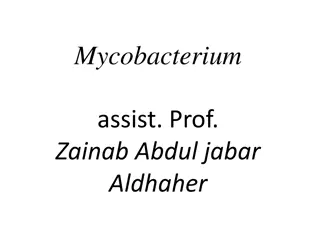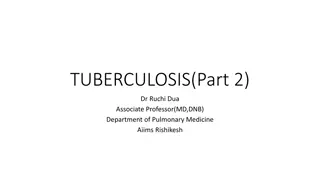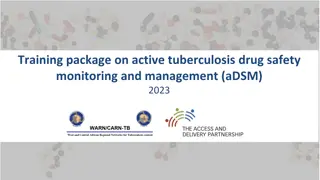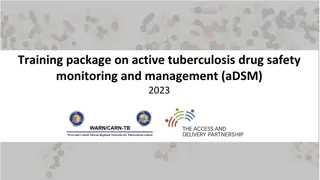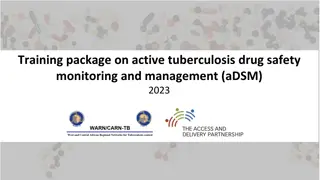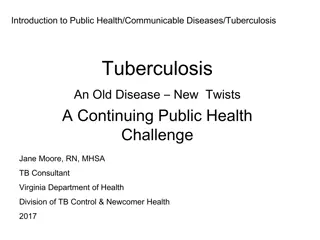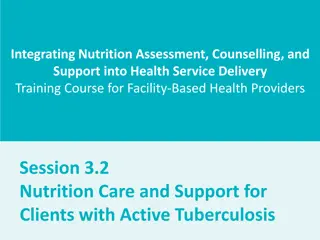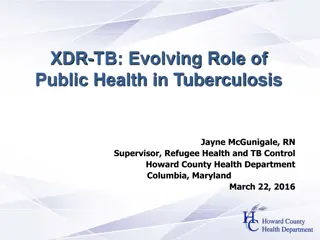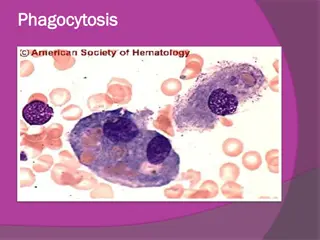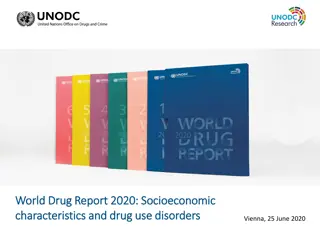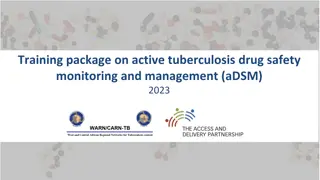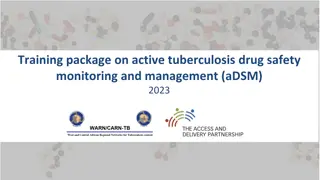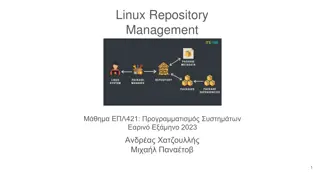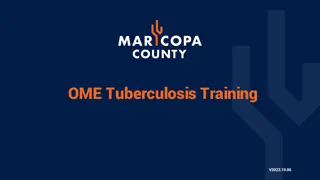Training Package on Active Tuberculosis Drug Safety Monitoring
In 2023, a training package on active tuberculosis drug safety monitoring and management (aDSM) was developed, focusing on key steps in aDSM implementation, standard data collection materials, and learning objectives. The presentation covers identifying core package standard data elements, creating comprehensive databases, and adapting recording systems. Additionally, aDSM report forms and standard data capture for TB treatment programs are discussed.
Uploaded on Mar 07, 2025 | 0 Views
Download Presentation

Please find below an Image/Link to download the presentation.
The content on the website is provided AS IS for your information and personal use only. It may not be sold, licensed, or shared on other websites without obtaining consent from the author.If you encounter any issues during the download, it is possible that the publisher has removed the file from their server.
You are allowed to download the files provided on this website for personal or commercial use, subject to the condition that they are used lawfully. All files are the property of their respective owners.
The content on the website is provided AS IS for your information and personal use only. It may not be sold, licensed, or shared on other websites without obtaining consent from the author.
E N D
Presentation Transcript
Training package on active tuberculosis drug safety monitoring and management (aDSM) 2023
Key steps in aDSM implementation Create a national coordinating mechanism for aDSM Develop a plan for aDSM Define management and supervision roles and responsibilities Create standard data collection materials Train staff on the collection of data Define schedules and routes for data collection and reporting Consolidate aDSM data electronically Develop capacity for signal detection and causality assessment
Learning objective By the end of this presentation, the participant is expected to be able to: 1. Identify aDSM core package standard data elements 2. Identify aDSM comprehensive database standard data elements 3. Create or adapt existing recording and reporting systems to include aDSM standard data elements
aDSM Report Forms (1) alert, full report AE or SAE Report Form Treatment initiation Patient review To be adapted to the tools used by the NTP To be adapted to the tools used by the NTP
aDSM Report Forms (2) There are 3 instances at which data are expected to be collected and reported: 1. Alert of a suspected/confirmed Serious adverse events (SAE) 2. Initial detailed report following the alert SAE 3. Review detailed report following initial report TB programmes may develop separate forms (paper or electronic) for the reporting at these three steps Otherwise they may adapt, e.g; Initial detailed report doubles as an alert form, with full details on this form completed later, after the alert
Standard Data Capture A standard data elements list has been developed comprising of a minimum dataset needed for aDSM data collection in TB treatment programmes This list enables national TB treatment programmes and software developers to incorporate the standard aDSM data elements in their existing recording and reporting systems
aDSM Core Package Data Elements The next slides list the aDSM core package data elements More details (suggested field name, format, category coding and labels) are available in the document available from the global PV database administrator Separate sections: Case & patient identifiers; Patient demographics; Facility details; Patient details at time of event; Laboratory assessment AE description (including action & outcomes); Medical treatment; Medical history;
PATIENT ID, DEMOGRAPHICS & FACILITY DETAILS Variable Case ID number Additional information Case identification number in national database. Automated consecutive number generated by national database Local Adverse Event identifier Local identifier for adverse event (optional) Worldwide unique case identification number International unique AE case identifier for the ICSR. If case was not assigned an international unique AE case identifier, leave blank. Country of the primary source Name of the primary source Site ID number Country Facility name Site identifier ID number Sex Date of birth Patient ID number in country database. Patient s gender Birth date in format (DD-MMM-YYYY). Can be stored as 3 different fields (day, month, year) to simplify management of partial date. Full date of birth should only be transferred to central database if allowed by regulation.
PATIENT DETAILS AT TIME OF EVENT Variable Patient onset age Height Weight Pregnancy status at start of event If pregnant, date of LMP Additional information Age of the patient at the time of the AE/SAE onset Patient height in cm (rounded, with no decimals) Patient weight in kg (rounded, with no decimals) Indicates whether the patient was pregnant at the time of the onset of AE/SAE. Start date of Last Menstrual Period (the first day of the most recent menstrual cycle) (DD-MMM-YYYY) Date can be stored as 3 different fields (day, month, year) to simplify management of partial date. Estimated Gestational Age (expressed in weeks) at start of the event (an approximate calculation of the gestational age of the fetus at start of the event). Indicates HIV status at the time of the AE onset If pregnant, gestation week at start of event HIV Status
AE DESCRIPTION (1) Variable Adverse Events Description Adverse event coding Additional information Verbatim (i.e., investigator-reported term) description of the adverse event Dictionary-derived text description of the adverse event. Equivalent to the Preferred Term (PT in MedDRA). Start date of the AE/SAE using this format (DD-MMM-YYYY). Can be stored as 3 different fields (day, month, year) to simplify management of partial date. AE/SAE stop date. Date that the AE resolved or led to death using this format (DD-MMM-YYYY). If the AE is ongoing, this field should be blank. Can be stored as 3 different fields (da, months, year) to simplify management of partial date. Maximum grade of the intensity of the AE Action taken to manage the AE/SAE Outcome of the event in relation to the subject s status. Select Death Related to Adverse Event for The termination of life as a result of an adverse event. Select Not Recovered or Not Resolved to indicate that the event has not improved or recuperated. Select Recovered or Resolved if the event has improved or recuperated. Select Recovered or Resolved with Sequelae if the subject recuperated but retained pathological conditions resulting from the prior disease or injury. Select Recovering or Resolving if the event is improving but has not yet fully recovered Select Unknown if the outcome was not known, not observed or not recorded Date of AE onset Event End date Intensity Action taken Outcome Event classified as Serious Death Indicates whether or not the adverse event is determined to be 'serious'. If SAE is it: Death? Indicates if a 'serious' adverse event resulted in death. PT: MedDRA preferred term, MedDRA: Medical Dictionary for Regulatory Activities
AE DESCRIPTION (2) Variable Autopsy Life Threatening Additional information In case of death: Was an autopsy done? If SAE is it: Life Threatening ? Indicates if a 'serious' adverse event was life threatening. Hospitalisation If SAE is it: Hospitalisation required or prolonged hospitalisation ? Indicates if a 'serious' adverse event resulted in an initial or prolonged hospitalization. Disability If SAE is it: Persistent/significant disability ? Indicates if a 'serious' adverse event was associated with a persistent or significant disability or incapacity. Congenital anomaly/birth defect If SAE is it: Congenital anomaly/birth defect? Indicates if a 'serious' adverse event was associated with a congenital anomaly or birth defect. Other medical important event If SAE is it: Other medical event considered as important ? Indicates if a 'serious' adverse event is associated with other serious or important medical events. Report to national PV center Indicates if the event was reported to the national pharmacovigilance center Narrative / Additional information Additional comment (free text) Do you wish to mark this safety case as nullified? This item should be used to indicate that a safety case previously recorded should be considered completely void (nullified), for example when the whole case was found to be erroneous. Why are you nullifying the safety case? Reason for nullification
MEDICAL TREATMENTS (1) Variable Additional information Drug name Name of the treatment(s) as originally received or collected. Commercial name(s) if possible, otherwise use generic name(s). Name of the treatment(s) in a coded format defined Total dose(s) taken per day Unit of dose(s) or amount taken per period recorded (e.g., ng, mg, mg/kg) Frequency (as days per weeks) Frequency the treatment(s) was administered in days per week Code for drug name Daily dose Dose unit Route of administration Record the route(s) of administration (e.g., Intra Venous, ORAL, TRANSDERMAL) If other, specify Date when administration of the treatment(s) began using this format (DD-MMM-YYYY). Can be stored as 3 different fields (day, month, year) to simplify management of partial date. Drug start date Drug stop date Date when administration of the treatment(s) ended using this format (DD-MMM-YYYY). Can be stored as 3 different fields (day, month, year) to simplify management of partial date. Indicates if the drug(s) are still taken. It is expected that every reported drug should have either an End Date or the Ongoing field marked 'yes', but not both. Drug still ongoing
MEDICAL TREATMENTS (2) Variable Action taken with drug after AE/SAE Relationship of the drug to the AE/SAE (evaluation made by reporting site) Relationship of the drug to the AE/SAE (evaluation made at country central level) Response to dechallenge Rechallenge Response to rechallenge Additional information Changes made to the drug in response to the adverse event. Reporting site's opinion as to the causal relationship between the drug and the adverse event Records the central level opinion as to the causal relationship between the drug and the adverse event Did the event improve after stopping/ reducing the dose reduced? Was the drug reintroduced? Did the event reappear after rechallenge? Event recurrence on drug re- administration. Unknown indicates that a rechallenge was done but it is not known if the event recurred.
MEDICAL HISTORY Variable Additional information Concurrent medical disorder Record if there were any relevant past and/or concomitant medical conditions or surgeries, present at the onset of the AE/SAE that may constitute a possible cause or a risk factor? Describe the relevant past and/or concomitant medical conditions or surgeries, present at the onset of the AE/SAE and that may constitute a possible cause or a risk factor. In language used in local database. If yes specify (in local language) If yes specify (in English) Record all relevant past and/or concomitant medical conditions or surgeries, present at the onset of the AE/SAE and that may constitute a possible cause or a risk factor. In English. Dictionary-derived text description of MHTERM. Equivalent to the Preferred Term (PT in MedDRA). Indicate if the medical condition is still ongoing at the time of the onset of the AE/SAE Coding of medical condition Is the medical condition still ongoing? MHTERM: Reported Term for the Medical History
LABORATORY ASSESSMENT Variable Additional information What is the lab test name? Indicate test name of the lab test performed for the investigation of the patient Date of test in format (DD-MN-YYYY). Can be stored as 3 different fields (day, month, year) to simplify management of partial date. Result of the measurement or finding, as originally received or collected. Date when lab test is done Result Unit Units Normal low range Lower Limit Normal Normal high range Upper Limit Normal
Alert form for SAE (1) The alert form is intended to inform the programme about the occurrence of a suspected or confirmed SAE as soon as possible The primary purpose of the alert form is to trigger action (clinical attention and further investigation) This form does not include all the data about the event needed for national or global surveillance. Upon receipt of the form, the person responsible for aDSM in the TB programme needs to collect all other necessary details The shape and content of the alert form depends on the programme needs. A programme may decide to use the same form as A sample data collection form incorporating aDSM core package standard data elements is presented in the following slide
Alert form for SAE (2) minimum contents of an alert form for SAE from Active tuberculosis drug-safety monitoring and management (aDSM). Framework for implementation. (WHO/HTM/TB/2015.28). Geneva, World Health Organization; 2015
Incorporate aDSM standard data elements into routine R&R forms (1) The NTP or aDSM Coordinating mechanism will Ensure core package standard data elements are incorporated in existing SAE forms Or create new SAE forms if appropriate Select elements from the comprehensive database standard data elements As appropriate for intermediate or advanced level of monitoring
Incorporate aDSM standard data elements into routine R&R forms (2) Integrate data selected from the comprehensive database standard data elements (paper or electronic) into existing data collection tools Indicate on a source data table where the selected data elements can be found, such as Patient medical records Laboratory records Pharmacy records Standard WHO recording and reporting forms Existing electronic databases Prepare pilot data collection forms
Pre-test and Finalize Forms Choose 3 to 5 SAE cases to pre-test the forms Make revisions and improvements to the forms as needed Finalize forms before training data collectors Note that data collectors may provide suggestions for improving the forms Forms may be finalized after the first training
Conclusions The data elements required for aDSM at country and global level should allow to record the essential details needed for causality assessment, signal detection and the generation of indicators. Standardization of the variables collected is important to allow comparison over time and between countries The data element list should inform the creation or modification of TB recording and reporting systems (paper or electronic) Alert forms are useful to inform the programme rapidly of suspected or confirmed SAEs in order to take necessary action
Acknowledgements The development of the aDSM training material was funded by TDR as part of the Access and Delivery Partnership (ADP) with funding from the Government of Japan. These training materials were put together in 2016 the WHO Task Force on aDSM with technical partners KNCV Tuberculosis Foundation, Management Sciences for Health (SIAPS), MSF, WHO GTB, and TDR. The materials were updated in 2022-23 by Mahamadou Bassirou Souleymane (TDR consultant) with Marie-Eve Raguenaud (TDR), Branwen J Hennig (TDR), and Corinne Merle (TDR), and reviewed by Linh Nhat Nguyen (WHO/GTB), Medea Gegia (WHO/GTB), and Fuad Mirzayev (WHO/GTB). We thank all members of the WARN/CARN-TB working group on aDSM who contributed to the development of the aDSM generic guidelines as well as the secretariat, particularly Dr Christ Houessinon: Disadidi Ambrioso, Esse Marius, Adomou Jamal Rouamba Ruffine, Haro Sougrimani, Koumbem Boureima, Nsanzerugeze Jos lyne, Tollo Tollo Daniel Alphonse D sir , Mpaba Minkat Th ophile Mistral, Julie Abessolo, Ursule IDOKO, Tijan Baldeh , Wandifa Samateh, Tida S Kinteh, Alieu Wurie, Mardemn Yeasuen, Benjamin K. Quenneh, Cheick Oumar Bah, Kane El Hadj Malick, Aw Idriss, Mamoudou Hama Rachida, Gagara I. M. Assiatou, Katamb Balkissa, Seiyabatou ElhSaidou, Liombo Anastasie, Lunganyu Junior, Kitambala Sentime, Lula Yves , Habimana-Mucyo Yves, Migambi Patrick, dos Santos Brigite, Castro V nia, Wadson Cruz, Gueye Aminata, Mukeh Fahnbulleh, Bailor Samuel, Manjo Lamin, Saleh Mahareb Abdoulaye, Haroun Saleh Naima, Mouhoudine Yerima, Kpelafia Silifa
